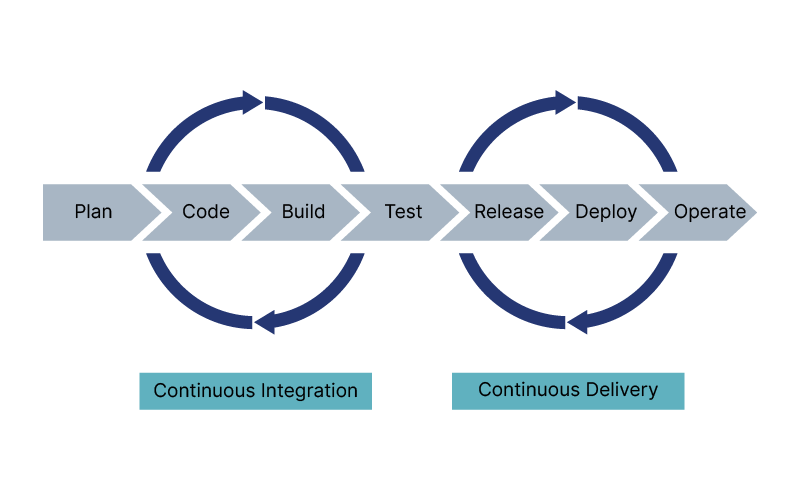Table of Contents
Even though enterprise-level companies are those who perhaps most often deploy the AWS IaC methodology to scale infrastructures according to their needs and workloads, SMBs (small to medium-sized businesses) and the AWS Infrastructure as Code approach are also a match made in heaven. The IaC method is an extremely effective and cost-efficient way to build and deploy vast and scalable cloud environments – and do so quite quickly and painlessly.
This is especially useful and valuable for small and medium-sized businesses as IaC files feature high portability, are quickly and easily readable, and can be used as a documentation tool for IT administrators. Infrastructure as Code allows for effective management of your business environment via definition files or machine-readable scripts, mitigating the need for manual reading processes. This type of code deployment and automation delivers a consistent environment that is reliable, easily scalable, and secure, reducing traditional security risks from human error to a minimum.
The advantages of deploying the IaC approach have caused massive adoptions of this model, especially within the SMB landscape. The shift is still ongoing (62% of surveyed companies have done DevOps implementations over the last 5 years), but numerous businesses are yet to understand all the benefits of deploying development automation models like DevOps and IaC.
AWS Infrastructure as Code: The Need For IaC
One of the core features and benefits of the cloud is that all the resources this architecture provides can be codified (defined in code). This is also known as the “codify everything” concept.

This enables IaC-based environments to mitigate two major obstacles that traditional approaches to software engineering have been facing for a while: lack of modularity and low reusability levels.
- Modularity – a trait that enables small components of functionality to be assembled within a larger structure.
- Reusability – the trait that allows a single code piece to be used by multiple teams.
These benefits reduce the levels of redundancy in the workflow to a minimum. Granted, the Infrastructure as Code environment was also struggling with these two issues, but – luckily – the IaC model and available tools have evolved to obviate these challenges.
AWS Infrastructure as Code: A Brief Overview of Benefits
IaC tools bring about multiple benefits for almost all types of IT and cloud management projects:
- Repeatable Deployment – when deployment is consistent and repeatable, companies can easily redeploy their cloud environment in almost any context and scenario.
- Self-Documentation – since the IaC architecture is self-documenting (readable templates), it is much easier to understand and define all the components of your cloud environment.
- Shorter Deployment Timeframes – engineers can achieve faster deployment as they can share specific resource templates, which shortens build time significantly.
- Resource Reusability – engineers are able to delete resources without any unnecessary pressure as they can also bring them back as soon as they are needed.
- Environment Version Control – source control services enable you to version control your environment through a fast old environment rollback.
That said, let’s delve into some of the best practices for developing a scalable environment suitable for SMBs.
Using AWS CloudFormation
AWS CloudFormation is a tool/service that utilizes template files to automate the setup of AWS resources. It is typically used as an IaC tool or a cloud automation solution due to its ability to support (almost) all services that run on AWS, while it is also great for automating the deployment and setup of numerous IaaS offerings.
CloudFormation is often used to automate and configure workloads that run across AWS services, including EC2 compute service, S3, the IAM service used for access control configuring, etc. Basically, if you use a service that runs on AWS, it is highly likely that you can automate the configuration and deployment of that particular service using CloudFormation. To learn more about AWS CloudFormation best practices, we recommend reading this guide.
Using Terraform
Terraform is an infrastructure provisioning tool based on multi-cloud and multi-platform models. It is great for solving administrative pitfalls and creating an “execution plan” so you can outline in detail what happens when you run your code or text file.
Much like other IaC tools, Terraform utilizes configuration files for defining, deploying and destroying cloud infrastructures. The fact that this tool supports both – multiple cloud and on-premise services – makes it all the more enticing from the administrator’s standpoint. This allows IaC files to be easily converted into files deployable across on-prem environments, while they can also be expanded to support different platforms – AWS, Google Cloud, Microsoft Azure, etc.
One seemingly discouraging thing about Terraform is that its files are written in HCL – Hashicorp Configuration Language. But learning this language shouldn’t be too much of a hassle as it is quite similar to the YAML markdown language.
Terraform files can be divided into 3 core types of components:
- Providers – the files used to define which types of environment you need (AWS, Azure, GCP, etc)
- Variables – the files used for setting up the value that will be used throughout a file
- Resources – the files that will be deployed across your architecture
When a Terraform file completes its deployment, a state file is created. The state file defines and details the current configuration. There are scenarios where it makes sense to use Terraform and CloudFormation at the same time as they are both provisioning tools. You can use Terraform to run templates from CloudFormation, while it can also be used as a wrapper. This enables you to use AWS’s Service Catalog (anything from servers, virtual machine images, to databases and software).
Perhaps the main advantage of AWS Infrastructure as Code is AWS’s ability to tightly integrate with all other AWS services, allowing you to perform almost any task. This enables you to build templates easily for experimentation purposes, as well as come up with best infrastructure practices for your unique needs.
Deploying CI/CD Pipelines
The CI/CD (Continuous Integration / Continuous Delivery) pipeline is the practice that combines continuous integration and either continuous delivery or continuous deployment. The method is designed for bridging the gaps between development and operation activities and teams by enforcing automation in the following stages:
- Building
- Testing
- Deployment

Basically, it is a process that defines and provisions all the architecture resources in a cloud environment using a simple text file and is used to model and provision all the necessary resources across all accounts and regions.
Now, simply spinning up an EC2 instance is quite easy, but doing it the right and optimal way – along with a complex ecosystem of services – is not exactly a breeze of a task. Assembling an optimal and proper combination of interconnected services requires advanced and versed knowledge and the know-how in terms of which cloud services offer what capabilities and benefits.
However, traditional start-up and SMB environments can reap numerous rewards for deploying IaC and CICD models, especially with an adequate help of an avid team of experts who do this professionally.
The right DevOps, IaC and cloud infrastructure experts can help traditional SMB environments to deploy optimal CI/CD systems and quickly write Infrastructure as Code so the code is effortlessly and accurately deployed and additional infrastructure services launched properly. This enables your development teams to immediately be able to code within optimally provisioned VPCs, allowing your computing power to handle growing workloads and scale up in a quick and cost-effective manner. This type of environment can help your teams significantly reduce TTM (time to market).
IaC Resource Provisioning
A good practice is to use AWS CloudFormation to write a simple text file that you can use as “the single source of truth” for your cloud environment. When code is used to automate VM’s setup and configuration process, it allows you to have a reliable, quick and – most importantly – repeatable method that you can use to replicate the process whenever you need to scale up.
This brings many advantages when compared to performing these tasks within legacy infrastructures, especially when your company growth requires customization and additional deployments. Scaling up and performing onboarding processes manually is a long and costly procedure, but the IaC method turns this process into a hassle-free and low-risk operation.
For automated deployments, it is recommended to develop tools and proof of concepts by carefully evaluating all the necessary features. You can use Terraform to deploy multiple single-tenant applications via Infrastructure as Code, ensuring quick rollouts of additional environments, as well as defining a protocol for your Beta and QA purposes and do so consistently for each tenant.
Some of the common third-party services and tools that are often used:
- Jenkins – can be used as an automation server for custom deployments.
- Rollbar – can be used for crash reports and real-time error tracking.
- Bitbucket – can be used for code versioning, collaboration, etc.
- Terraform – can be used to automate infrastructure creation and environment rollout on multiple cloud providers.
- New Relic – good for tracking application performance and distributed tracing.
- Amazon EC2 – for Auto Scaling, maintenance of application availability, automated adding/removing EC2 instances, etc.
- AWS RDS – for managing and launching Relational Databases.
- Amazon ElastiCache – used to deploy/operate/scale the in-memory data store/cache within your cloud environment.
- AWS Elastic Beanstalk – for quick deployment and management of applications.
- AWS CloudWatch – for monitoring the overall health of your future architecture.
- Elastic Load Balancing – for the distribution of incoming traffic across multiple targets in multiple Availability Zones.
- Amazon Virtual Private Cloud – for launching AWS resources into a virtual interconnected network.
- Amazon Elastic Container Service – for easy container management.
- Amazon S3 – for storing all the static assets.
- Amazon CloudFront – used as the Content Delivery Network (CDN).
- AWS Lambda – for running code without provisioning or managing servers.
Final Thoughts
The IaC model is definitely both the present and the future of scalable cloud architectures. Companies that seek efficient automation, faster delivery, and an overall improved development environment are en-masse moving onto IaC-based infrastructures.
The problem is that designing optimal IaC solutions for your unique IT architecture cannot be done without adequate experience, know-how, sufficient resources, or a lack of proper guidance. But once you manage to build a scalable IaC environment that caters to all your company needs, your development workflow will instantly start producing amazing results.
We know that we’ve merely scratched the surface of using AWS Infrastructure as Code to build a scalable infrastructure for your SMB. However, the SuperAdmins team can help you audit and build a perfectly scalable infrastructure. We can help you perform an effective IaC implementation so your business can leverage all the benefits of scalable architectures that are waiting to be discovered.
